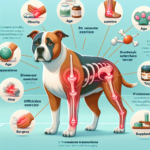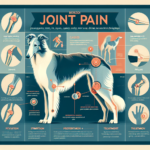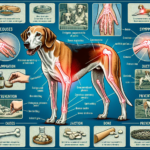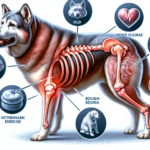Plott Hound Joint Pain: Causes, Symptoms, Prevention, and Treatment
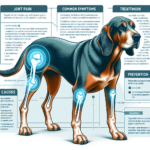
Introduction
The Plott Hound is a breed with a rich history and distinctive characteristics. Originating from Germany and later developed in the United States, the Plott Hound is known for its exceptional hunting abilities, particularly in tracking and hunting boar. This breed is characterized by its muscular build, keen sense of smell, and a tenacious spirit. Plott Hounds are also known for their loyalty and intelligence, making them excellent companions and working dogs.
Like many breeds, Plott Hounds are susceptible to certain health issues, with joint pain being a significant concern. Joint health is crucial for this breed due to their active lifestyle and the physical demands placed on their bodies. Understanding the causes, symptoms, prevention, and treatment of joint pain in Plott Hounds is essential for ensuring their well-being and maintaining their quality of life.
Breed-Specific Joint Pain Risks
Genetic Predisposition
Plott Hounds, like many other breeds, have a genetic predisposition to joint-related issues. Conditions such as hip dysplasia, arthritis, and elbow dysplasia are common in this breed. Hip dysplasia, in particular, is a hereditary condition where the hip joint does not fit properly into the hip socket, leading to pain and mobility issues. Arthritis, a degenerative joint disease, can also develop over time, causing inflammation and discomfort in the joints.
Age-Related Risks
As Plott Hounds age, the risk of developing joint pain increases. While younger dogs may not show immediate signs of joint issues, the wear and tear on their joints over the years can lead to problems later in life. Owners should be vigilant about monitoring their Plott Hound’s joint health, especially as they approach middle age (around 5-7 years) and senior years (8 years and older).
Activity Level and Joint Stress
Plott Hounds are known for their high energy levels and active lifestyles. They are often used for hunting, tracking, and other physically demanding activities. While regular exercise is essential for their overall health, excessive or high-impact activities can put additional stress on their joints. Owners should balance their Plott Hound’s activity level to prevent overexertion and potential joint damage.
Common Symptoms of Joint Pain in Plott Hounds
General Symptoms
Owners should be aware of common symptoms of joint pain in Plott Hounds, which include:
- Limping or favoring one leg
- Stiffness, especially after rest or exercise
- Reluctance to move, jump, or climb stairs
- Decreased activity or playfulness
- Swelling or heat around the joints
- Whining or showing signs of discomfort when touched
Breed-Specific Symptoms
In Plott Hounds, joint pain may manifest more noticeably due to their active nature. Owners might observe a sudden decrease in their dog’s enthusiasm for activities they once enjoyed, such as hunting or playing fetch. Additionally, Plott Hounds may exhibit a more pronounced limp or stiffness after engaging in high-energy activities.
When to Consult a Vet
If any of the above symptoms are observed, it is crucial to consult a veterinarian promptly. Early diagnosis and intervention can significantly improve the management of joint pain and prevent further deterioration. Regular veterinary check-ups are also essential for monitoring joint health and catching any issues early.
Preventive Measures for Joint Health
Exercise Recommendations
Maintaining an appropriate exercise routine is vital for the joint health of Plott Hounds. Low-impact activities such as walking, swimming, and controlled play are excellent options. These exercises help keep the joints mobile without causing excessive stress. Avoid activities that involve sudden stops, jumps, or sharp turns, as these can exacerbate joint issues.
Dietary Suggestions
A balanced diet rich in essential nutrients can support joint health in Plott Hounds. Foods containing glucosamine, chondroitin, and omega-3 fatty acids are particularly beneficial. These nutrients help maintain cartilage health and reduce inflammation. Owners may also consider joint supplements, but it is essential to consult a veterinarian before adding any supplements to the dog’s diet.
Weight Management
Maintaining a healthy weight is crucial for reducing joint stress in Plott Hounds. Excess weight puts additional pressure on the joints, exacerbating pain and discomfort. Owners should monitor their dog’s weight and adjust their diet and exercise routine accordingly. Regular weigh-ins and body condition assessments can help ensure the dog remains at an optimal weight.
Early Screening and Monitoring
Early screening for joint issues can help catch problems before they become severe. Regular veterinary check-ups should include joint assessments, especially for Plott Hounds with a family history of joint problems. X-rays and other diagnostic tools can help identify early signs of conditions like hip dysplasia or arthritis, allowing for timely intervention.
Treatment Options for Joint Pain
Non-Surgical Treatments
Non-surgical treatments are often the first line of defense against joint pain in Plott Hounds. These may include:
- Medications: Anti-inflammatory drugs and pain relievers can help manage pain and reduce inflammation.
- Physical Therapy: Exercises and therapies designed to improve joint mobility and strengthen surrounding muscles.
- Lifestyle Adjustments: Modifying the dog’s activity level and providing a comfortable living environment.
Surgical Options
In severe cases, surgical intervention may be necessary. Common surgical options for joint pain in Plott Hounds include:
- Hip Replacement: Replacing the damaged hip joint with an artificial one.
- Arthroscopy: A minimally invasive procedure to clean out the joint and remove damaged tissue.
- Joint Fusion: Fusing the joint to reduce pain and improve stability.
Surgical options should be discussed thoroughly with a veterinarian to determine the best course of action for the individual dog.
Alternative Therapies
Alternative therapies can complement traditional treatments and provide additional relief for joint pain. These may include:
- Acupuncture: Using needles to stimulate specific points on the body to relieve pain.
- Hydrotherapy: Water-based exercises that reduce joint stress while improving mobility.
- Massage: Gentle massage techniques to alleviate muscle tension and improve circulation.
Lifestyle and Management Tips
Daily Care Routine
A consistent daily care routine can help manage and alleviate joint pain in Plott Hounds. This may include:
- Regular, low-impact exercise to maintain joint mobility.
- A balanced diet with joint-supporting nutrients.
- Administering any prescribed medications or supplements.
- Monitoring the dog’s weight and adjusting their diet as needed.
Modifying the Home Environment
Making the home environment more comfortable for a dog with joint pain can significantly improve their quality of life. Consider the following modifications:
- Providing orthopedic beds for better joint support.
- Using ramps or steps to help the dog access furniture or vehicles.
- Ensuring food and water bowls are at a comfortable height.
- Keeping the living area free of obstacles to prevent tripping or slipping.
Long-Term Management
Long-term management strategies are essential for keeping a Plott Hound active and happy despite joint pain. These may include:
- Regular veterinary check-ups to monitor joint health.
- Adjusting the exercise routine as the dog’s condition changes.
- Continuing with any prescribed treatments or therapies.
- Providing mental stimulation through training and interactive toys to keep the dog engaged.
FAQs About Plott Hounds and Joint Pain
What are the early signs of joint pain in Plott Hounds?
Early signs of joint pain in Plott Hounds include limping, stiffness, reluctance to move, and decreased activity levels. Owners should also watch for signs of discomfort when the dog is touched or when they attempt to climb stairs or jump.
Can joint pain in Plott Hounds be prevented?
While it may not be possible to prevent joint pain entirely, taking preventive measures such as maintaining a healthy weight, providing a balanced diet, and ensuring regular, low-impact exercise can significantly reduce the risk and severity of joint issues.
Are there specific supplements that can help with joint health in Plott Hounds?
Yes, supplements containing glucosamine, chondroitin, and omega-3 fatty acids can support joint health in Plott Hounds. However, it is essential to consult a veterinarian before adding any supplements to the dog’s diet.
When should I consider surgery for my Plott Hound’s joint pain?
Surgery should be considered when non-surgical treatments are no longer effective, and the dog’s quality of life is significantly impacted by joint pain. A veterinarian can help determine the best course of action based on the dog’s specific condition and overall health.
Conclusion
Joint pain is a common concern for Plott Hounds, but with proper care and attention, it can be managed effectively. Understanding the causes, symptoms, prevention, and treatment options is crucial for maintaining the health and well-being of this active and loyal breed. By taking preventive measures, providing appropriate treatment, and making necessary lifestyle adjustments, owners can help their Plott Hounds lead happy, pain-free lives. Regular veterinary consultations are essential for monitoring joint health and ensuring timely intervention when needed.

